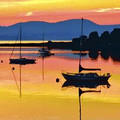的点评
Wonderful complex view of North Vancouver—small but lots to see
Monova: Archives Of North Vancouver的点评
点评:A real pleasure to visit this splendid if a little quirky museum. From the prominence of the restored streetcar in the entrance, you might think it’s a typical “small city” museum (artifacts about city growth and such). Several special exhibits caught our eye pleasantly enough, who doesn’t want to know more about the nearby mountains and mountaineering culture? But already there is deft integration of local First Nations people with white European folks on skis.
The heart of the place, however, is the building-wide permanent exhibition. Pause a moment when you enter, you are invited as it were to branch one way into cultural change and transformation; straight ahead is a compact but valuable treatment of two local First Nations culture, tools, and language — multimedia gives you the sound of the languages— very nice to hear. (Not all “sweetness and light” since a semi-enclosed panel deals directly with the reservation school calamity—a voice intones the names of its victims. ) The other way you can explore the prominent local shipbuilding industry. There’s a lot of great information, expertly presented — multiple level descriptions.
The museum deserves a wider exposure— really a treat, a short walk from the SeaBus terminal.
The heart of the place, however, is the building-wide permanent exhibition. Pause a moment when you enter, you are invited as it were to branch one way into cultural change and transformation; straight ahead is a compact but valuable treatment of two local First Nations culture, tools, and language — multimedia gives you the sound of the languages— very nice to hear. (Not all “sweetness and light” since a semi-enclosed panel deals directly with the reservation school calamity—a voice intones the names of its victims. ) The other way you can explore the prominent local shipbuilding industry. There’s a lot of great information, expertly presented — multiple level descriptions.
The museum deserves a wider exposure— really a treat, a short walk from the SeaBus terminal.
翻译:参观这个虽然有点古怪但很出色的博物馆真的是一种享受。从入口处修复的有轨电车的显眼位置来看,您可能会认为这是一个典型的“小城市”博物馆(关于城市发展等的文物)。几个特别的展览令人愉快地吸引了我们的眼球,谁不想更多地了解附近的山脉和登山文化呢?但是,当地原住民和滑雪的白人欧洲人已经巧妙地融合在一起了。
然而,这个地方的核心是整个建筑的常设展览。当您进入时稍作停留,您会被邀请进入文化变革和转型的一个分支;直走是对两个当地原住民文化、工具和语言的紧凑但有价值的处理——多媒体让您听到语言的声音——听起来非常好听。(并非所有的“甜蜜和光明”都是如此,因为半封闭的面板直接涉及保留学校的灾难——一个声音吟诵着受害者的名字。)另一种方式是您可以探索当地著名的造船业。有很多很棒的信息,专业呈现——多层次的描述。
博物馆值得更广泛的曝光——真的是一种享受,距离 SeaBus 终点站仅几步之遥。
然而,这个地方的核心是整个建筑的常设展览。当您进入时稍作停留,您会被邀请进入文化变革和转型的一个分支;直走是对两个当地原住民文化、工具和语言的紧凑但有价值的处理——多媒体让您听到语言的声音——听起来非常好听。(并非所有的“甜蜜和光明”都是如此,因为半封闭的面板直接涉及保留学校的灾难——一个声音吟诵着受害者的名字。)另一种方式是您可以探索当地著名的造船业。有很多很棒的信息,专业呈现——多层次的描述。
博物馆值得更广泛的曝光——真的是一种享受,距离 SeaBus 终点站仅几步之遥。
旅行类型:情侣游
此点评仅代表旅行者个人的主观意见,并不代表TripAdvisor以及其合作方的意见。
关于我们
|
新闻动态
|
商务合作
|
会员中心
|
业主中心
|
业主通
|
常见问题
|
意见反馈
|
联系我们
|
营业执照
© 2025 Tripadvisor 版权所有。
使用条款 |隐私政策 |网站工作原理
部分照片由 VFM Leonardo 提供。
* Tripadvisor不是旅行社,也不是旅游预订服务代理商。我们提供免费、客观、公正的旅游资讯服务。 (显示更多)
TripAdvisor LLC 既不是预订代理商,也不是旅游运营商,不会向网站用户收取任何服务费。 按照规定,在 Tripadvisor 发布机票价格、游览和旅行套餐的合作伙伴(航空公司、旅行提供商及预订代理商),其标价须包含所有费用和附加费用。 例如, 机场出入境税费、消费税与其他服务费、手续费、杂费及附加费用。 当您向我们的某个合作伙伴进行预订时,请务必查阅他们的网站以了解当地行政部门要求的所有适用费用的具体情况。 除非另有说明,机票价格通常指的是一个人的价格(以人民币计)。
为方便起见,TripAdvisor LLC 根据从我们的预订合作伙伴获取的空房率计算每个酒店的均价。 对于游览和景点来说,所显示价格通常是每位成人的最低可用价格。 对于列出的任何旅行套餐或优惠,TripAdvisor LLC 无法保证任何特定的费率或价格。 此外,酒店均价每晚会更新,并以您的首选币种表示(使用现行汇率)。 由于这些已换算的价格是预估价格,因此,有关具体金额和币种请与预订网站进行核实。
此外,TripAdvisor LLC 无法保证我们网站上宣传的价格随时有效。 标价可能需要预订一定天数才能生效,或有不可用日期、使用条件或限制。
TripAdvisor公司对外部网站的内容一概不负责。优惠价格中不含税和其他费用。
ICP证:沪B2-20200433
沪ICP备20013175号
 沪公网安备31010502005427号
沪公网安备31010502005427号鹰程信息技术(上海)有限公司
货币/国家及地区
¥CNY
中国

